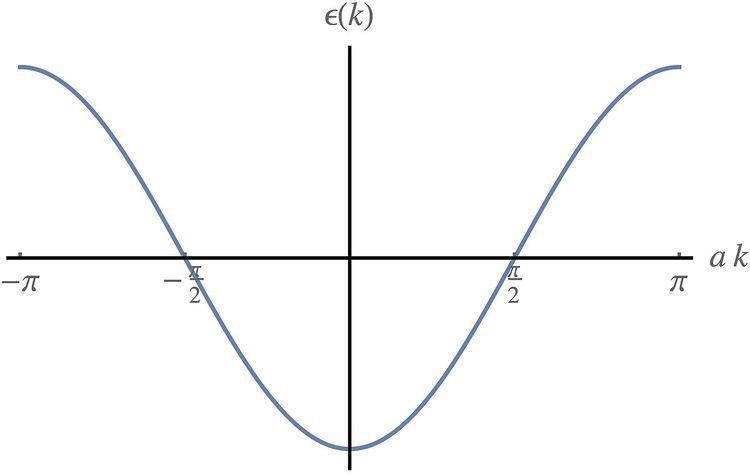 | ||
A Peierls transition or Peierls distortion is a distortion of the periodic lattice of a one-dimensional crystal. Atomic positions oscillate, so that the perfect order of the 1-D crystal is broken.
Contents
Peierls’ theorem
Peierls' theorem states that a one-dimensional equally spaced chain with one electron per ion is unstable.
It was asserted in the 1930s by Rudolf Peierls. It can be proven using a simple model of the potential for an electron in a 1-D crystal with lattice spacing
Imagine a lattice distortion where every other ion moves closer to one neighbor and further away from the other, the unfavourable energy of the long bond between ions is outweighed by the energy gain of the short bond. The period has just doubled from
Historical background
Peierls’ discovery gained experimental backing during the effort to find new superconducting materials. In 1964, Dr. William Little of the Stanford University Department of Physics theorized that a certain class of polymer chains may experience a high Tc superconducting transition. The basis for his assertion was that the lattice distortions that lead to pairing of electrons in the BCS theory of superconductivity could be replaced instead by rearranging the electron density in a series of side chains. This means that now electrons would be responsible for creating the Cooper pairs instead of ions. Because the transition temperature is inversely proportional to the square root of the mass of the charged particle responsible for the distortions, the Tc should be improved by a corresponding factor:
The subscript i represents "ion", while e represents "electron". The predicted benefit in superconducting transition temperature was therefore a factor of about 300.
In the 1970s, various organic materials such as TTF-TCNQ were synthesized. What was found is that these materials underwent an insulating transition rather than a superconducting one. Eventually it was realized that these were the first experimental observations of the Peierls transition. With the introduction of new band gaps after the lattice becomes distorted, electrons must overcome this new energy barrier in order to become free to conduct. The simple model of the Peierls distortion as a rearrangement of ions in a 1-D chain could describe why these materials became insulators rather than superconductors.
Related physical consequences
Peierls predicted that the rearrangement of the ion cores in a Peierls transition would produce periodic fluctuations in the electron density. These are commonly called charge density waves, and they are an example of collective charge transport. Several materials systems have verified the existence of these waves. Good candidates are weakly coupled molecular chains, where electrons can move freely along the direction of the chains, but motion is restricted perpendicular to the chains. NbSe3 and K0.3MoO3 are two examples in which charge density waves have been observed at relatively high temperatures of 145 K and 180 K respectively.
Furthermore, the 1-D nature of the material causes a breakdown of the Fermi liquid theory for electron behavior. Therefore, a 1-D conductor should behave as a Luttinger liquid instead. A Luttinger liquid is a paramagnetic one-dimensional metal without Landau quasi-particle excitations.
Research topics
1-D metals have been the subject of much research. Here are a few examples of both theoretical and experimental research efforts to illustrate the broad range of topics:
